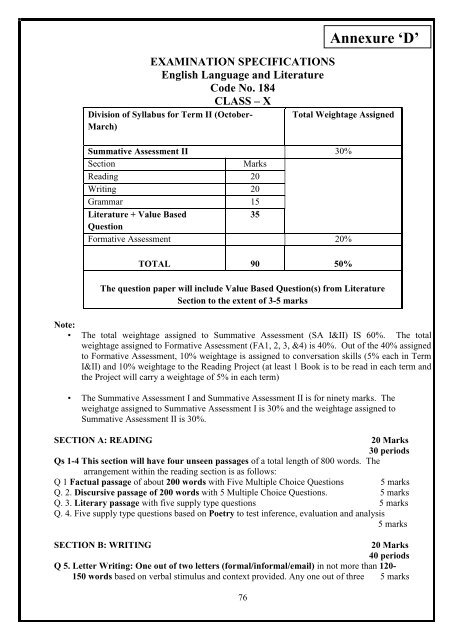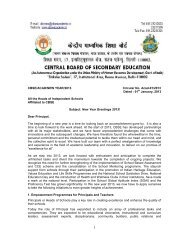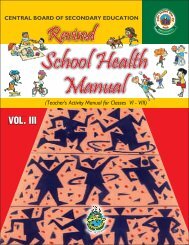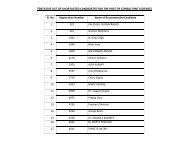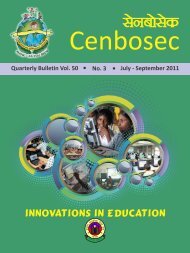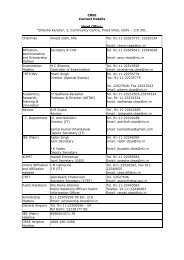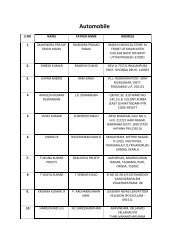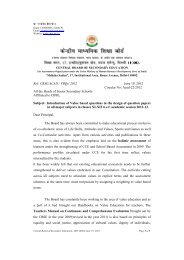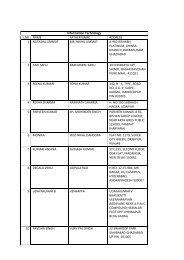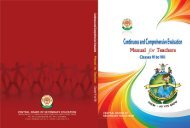English Language and Literature - CBSE
English Language and Literature - CBSE
English Language and Literature - CBSE
Create successful ePaper yourself
Turn your PDF publications into a flip-book with our unique Google optimized e-Paper software.
EXAMINATION SPECIFICATIONS<br />
<strong>English</strong> <strong>Language</strong> <strong>and</strong> <strong>Literature</strong><br />
Code No. 184<br />
CLASS – X<br />
Division of Syllabus for Term II (October-<br />
March)<br />
76<br />
Total Weightage Assigned<br />
Summative Assessment II 30%<br />
Section<br />
Marks<br />
Reading 20<br />
Writing 20<br />
Grammar 15<br />
<strong>Literature</strong> + Value Based<br />
35<br />
Question<br />
Formative Assessment 20%<br />
TOTAL 90 50%<br />
Annexure ‘D’<br />
The question paper will include Value Based Question(s) from <strong>Literature</strong><br />
Section to the extent of 3-5 marks<br />
Note:<br />
• The total weightage assigned to Summative Assessment (SA I&II) IS 60%. The total<br />
weightage assigned to Formative Assessment (FA1, 2, 3, &4) is 40%. Out of the 40% assigned<br />
to Formative Assessment, 10% weightage is assigned to conversation skills (5% each in Term<br />
I&II) <strong>and</strong> 10% weightage to the Reading Project (at least 1 Book is to be read in each term <strong>and</strong><br />
the Project will carry a weightage of 5% in each term)<br />
• The Summative Assessment I <strong>and</strong> Summative Assessment II is for ninety marks. The<br />
weighatge assigned to Summative Assessment I is 30% <strong>and</strong> the weightage assigned to<br />
Summative Assessment II is 30%.<br />
SECTION A: READING<br />
20 Marks<br />
30 periods<br />
Qs 1-4 This section will have four unseen passages of a total length of 800 words. The<br />
arrangement within the reading section is as follows:<br />
Q 1 Factual passage of about 200 words with Five Multiple Choice Questions 5 marks<br />
Q. 2. Discursive passage of 200 words with 5 Multiple Choice Questions. 5 marks<br />
Q. 3. Literary passage with five supply type questions 5 marks<br />
Q. 4. Five supply type questions based on Poetry to test inference, evaluation <strong>and</strong> analysis<br />
5 marks<br />
SECTION B: WRITING<br />
20 Marks<br />
40 periods<br />
Q 5. Letter Writing: One out of two letters (formal/informal/email) in not more than 120-<br />
150 words based on verbal stimulus <strong>and</strong> context provided. Any one out of three 5 marks
• Informal letters-– personal, such as to family <strong>and</strong> friends<br />
• Formal letters – letters to the editor<br />
• Email: formal letters to principal of the schools or to the Editor of a Newspaper or a Magazine.<br />
Q. 6. An article or a speech in 120 – 150 words, based on stimulus provided. (Any out of two).<br />
5 marks<br />
Q. 7. A debate in not more than 120-150 words, based on the stimulus provided. 5 marks<br />
Q. 8. A composition in the form of dialogue writing/ story or report of minimum<br />
120-150 words (one out of two) 5 marks<br />
SECTION C: GRAMMAR<br />
This section will assess Grammar items in context for 15 marks.<br />
This section will carry four questions<br />
15 Marks<br />
45 periods<br />
Q. 9 will have MCQs of three marks .The test types for MCQs include: 3 marks<br />
• Gap filling<br />
• Sentence completion<br />
Q. 10 will have MCQs of three marks. The test type for MCQ will be based on: 3 marks<br />
• Dialogue Completion<br />
Q. 11 Three supply type questions test type include sentence reordering: 3 marks<br />
Q. 12 Supply type questions on editing / omission 6x1 = 6 marks<br />
Questions 11 <strong>and</strong> 12(total 9 marks) will be based on response supplied by students. (Supply<br />
Type Questions)<br />
These test types which will not be tested as MCQs include<br />
• Sentence reordering<br />
• Editing/ Omission<br />
• Sentence transformation (including combining of sentences)<br />
The Grammar syllabus will include the following areas in class X:<br />
• Tenses<br />
• Modals (have to/had to, must, should, need, ought to <strong>and</strong> their negative forms)<br />
• Use of passive voice<br />
• Subject – verb concord<br />
• Reporting<br />
(i). Comm<strong>and</strong>s <strong>and</strong> requests<br />
(ii). Statements<br />
(iii). Questions<br />
• Clauses:<br />
• Noun clauses<br />
• Adverb clauses of condition <strong>and</strong> time<br />
• Relative clauses<br />
• Determiners, <strong>and</strong><br />
• Prepositions<br />
Note: No separate marks are allotted for any of the grammar items listed above.<br />
77
SECTION D: TEXT BOOKS<br />
35 Marks<br />
95 periods<br />
First Flight-NCERT Text Book for Class X<br />
Q13 (a) <strong>and</strong> 13 (b) Two extracts for reference to context (based on prose or play). These extracts<br />
would require effort on the part of the students to supply the responses.<br />
Up to one mark in each extract will be for vocabulary. At least one question will be used for testing<br />
local <strong>and</strong> global comprehension <strong>and</strong> one question will be on interpretation.<br />
The extracts will carry 4 marks each.<br />
8 Marks<br />
Q 14. Two reference to context stanzas (based on poetry) followed by 3 MCQs to test local <strong>and</strong> global<br />
comprehension of the set text .The extracts will carry 3 marks each.<br />
6 Marks<br />
Q15. Three out of four short answer type questions based on prose or play to test local <strong>and</strong><br />
global comprehension of theme <strong>and</strong> ideas ( 30 – 40 words) 2 marks each. 6 Marks<br />
Q16. One question based on values <strong>and</strong> key messages brought out on the basis of prescribed<br />
texts in about 120-150 words.<br />
5 Marks<br />
Footprints without Feet: NCERT Supplementary Reader for Class X<br />
10 Marks<br />
Q 17. One out of two long questions from supplementary reader to interpret, evaluate <strong>and</strong><br />
analyze character, plot or situations occurring in the lessons to be answered in about 80-<br />
100 words. 4 Marks<br />
Q 18 Two out of three short answer type questions based on factual aspects, interpretation <strong>and</strong><br />
evaluation of a lesson. (50-60 words)<br />
3x2 =6 Marks<br />
NOTE: Teachers are advised to:<br />
• encourage classroom interaction among peers, students <strong>and</strong> teachers through activities such<br />
as role play, group work etc,<br />
• reduce teacher-talking time <strong>and</strong> keep it to the minimum,<br />
• take up questions for discussion to encourage pupils to participate <strong>and</strong> to marshal their ideas<br />
<strong>and</strong> express <strong>and</strong> defend their views, <strong>and</strong><br />
• use the scale of assessment for conversation skills to test the students for continuous<br />
assessment.<br />
Besides measuring attainment, texts serve the dual purpose of diagnosing mistakes <strong>and</strong> areas of non-learning.<br />
To make evaluation a true index of learners’ attainment, each language skill is to be assessed through a<br />
judicious mixture of different types of questions. In addition to the summative tests, formative assessment is<br />
essential to measure the level of attainment in the four language skills <strong>and</strong> the learners’ communicative<br />
competence. Formative assessment should be done through ‘in class’ activities throughout the year.<br />
Prescribed Books Published by NCERT , Sri Aurobindo Marg, New Delhi.<br />
1. First Flight – Textbook for Class X<br />
2. Foot Prints without Feet – Supplementary Reader for Class X<br />
78
Reading Section:<br />
Reading for comprehension, critical evaluation, inference <strong>and</strong> analysis is a skill to be tested<br />
formatively as well as summatively.<br />
Writing Section:<br />
All types of short <strong>and</strong> extended writing tasks will be dealt with in both I <strong>and</strong> II Term Summative as<br />
well as in Formative Assessment.<br />
Grammar:<br />
Grammar items mentioned in the syllabus will be taught <strong>and</strong> assessed formatively over a period of<br />
time. There will be no division of syllabus for Grammar in the summative assessments for the two<br />
terms.<br />
NOTE:<br />
PLEASE NOTE THE MODIFIED WEIGHTAGE ALLOCATED TO QUESTIONS IN THE TEXTBOOKS SECTION<br />
79
ENGLISH LANGUAGE & LITERATURE COURSE<br />
CLASS X<br />
Syllabus for Second Term<br />
TEXTBOOKS<br />
<strong>Literature</strong> Reader (First Flight)<br />
PROSE<br />
1. A Baker from Goa<br />
2. Coorg<br />
3. Tea form Assam<br />
4. Mijbil the otter<br />
5. Madam Rides the<br />
Bus<br />
6. The Sermon at<br />
Benares<br />
7. The Proposal<br />
POETRY<br />
1. Animals<br />
2. The Trees<br />
3. Fog<br />
4. The Tale of Custard<br />
the Dragon<br />
5. For Anne Gregory<br />
Supplementary Reader<br />
(Footprints without Feet)<br />
1. The Making of a<br />
Scientist<br />
2. The Necklace<br />
3. The Hack Driver<br />
4. Bholi<br />
5. The Book that saved<br />
the Earth<br />
Note:<br />
1. Formative Assessment is assessment ‘for’ learning. Thus schools may adapt the above break-up as<br />
per their convenience.<br />
2. All activities related to Formative Assessment such as language games, quizzes, projects, role<br />
plays dramatisation, script writing etc must be done as ‘in class’ <strong>and</strong> ‘in school’ activities. In case,<br />
a field survey or visit is taken up, it must be under the direct supervision of the teacher.<br />
80
Design of Question Paper<br />
<strong>English</strong> (<strong>Language</strong> & <strong>Literature</strong>)(184)<br />
Class-X (2012-13)<br />
Division of Syllabus for Term II (October-March)<br />
Total Weightage Assigned<br />
Summative Assessment II 30%<br />
Section<br />
Marks<br />
Reading 20<br />
Writing 20<br />
Grammar 15<br />
<strong>Literature</strong> + Value Based<br />
35<br />
Question<br />
Formative Assessment 20%<br />
TOTAL 90 50%<br />
The question paper will include Value Based Question(s) from <strong>Literature</strong><br />
Section to the extent of 3-5 marks<br />
Sr.<br />
No.<br />
Skills to be<br />
tested<br />
1. READING<br />
COMPREHENSION<br />
2. READING<br />
COMPREHENSION<br />
3. READING<br />
COMPREHENSION<br />
4. READING<br />
COMPREHENSION<br />
Strategies<br />
Multiple Choice Questions<br />
on a factual passage of<br />
about 200 words<br />
Multiple Choice Questions<br />
on discursive passage of<br />
about 200 words<br />
Five supply type<br />
questions based on<br />
inference, evaluation <strong>and</strong><br />
analysis on a literary<br />
passage.<br />
Five supply type<br />
questions based on<br />
poetry to test inference,<br />
evaluation <strong>and</strong> analysis.<br />
No. of<br />
Total Marks<br />
Questions <strong>and</strong><br />
Marks<br />
5 MCQs x 1 = 05<br />
5 MCQs x 1 = 05<br />
5 VSAQs x 1 = 05<br />
5 VSAQs x 1 = 05<br />
TOTAL MARKS 20<br />
Remarks<br />
5. WRITING Letter writing: one out of<br />
two letters (formal/<br />
informal/ e-mail) in not<br />
more that 120- 150<br />
words based on verbal<br />
stimulus <strong>and</strong> context<br />
provided.<br />
Types of letter:<br />
Informal – personal,<br />
81<br />
1 LAQ II x5 = 05 Any<br />
one<br />
out of<br />
the 3
such as to family <strong>and</strong><br />
friends.<br />
Formal: letters to the<br />
Editor<br />
Email: formal letters to<br />
principal of the schools or<br />
to the Editor of a<br />
Newspaper or a<br />
Magazine.<br />
6. WRITING An article or a speech<br />
based on visual or verbal<br />
stimulus in 120-150<br />
words.<br />
7. WRITING A debate based on verbal<br />
stimulus in not more that<br />
120-150 word.<br />
8. WRITING A composition in the form<br />
of dialogue writing/ story<br />
or report of minimum<br />
120-150 words (one out<br />
of two)<br />
1 LAQ II x 5= 05 Any<br />
one<br />
out of<br />
two<br />
1 LAQ II x 5= 05<br />
1 LAQ II x 5= 05<br />
Total<br />
marks<br />
for<br />
Writing<br />
Sectio<br />
n = 20<br />
TOTAL MARKS 20<br />
9. GRAMMAR MCQs to test<br />
Gap Filling/<br />
Sentence<br />
Competition<br />
10. GRAMMAR MCQs to test<br />
dialogue completion<br />
11. GRAMMAR Supply Type Questions<br />
Sentence reordering<br />
3 MCQs x1 = 03<br />
3 MCQs x1 = 03<br />
3 VSAQs x1 = 03<br />
12. GRAMMAR Supply Type Questions<br />
Editing/ Omission<br />
6 VSAQs x1 = 06<br />
Total<br />
marks<br />
for<br />
Gram<br />
mar<br />
Sectio<br />
n = 15<br />
TOTAL MARKS 15<br />
13<br />
a)<br />
TEXT BOOKS<br />
(<strong>Literature</strong>)<br />
One extract for reference<br />
to context based on<br />
prose or play. This<br />
extract would require<br />
effort on the part of the<br />
students to supply the<br />
responses to four very<br />
short answer questions<br />
Upto one mark in the<br />
extract will be for<br />
vocabulary. At least one<br />
question will be used for<br />
testing local <strong>and</strong> global<br />
comprehension <strong>and</strong> one<br />
question will be on<br />
interpretation.<br />
4 VSAQs x 1 = 04<br />
82
13<br />
b)<br />
TEXT BOOKS<br />
(<strong>Literature</strong>)<br />
14 TEXT BOOKS<br />
(<strong>Literature</strong>)<br />
15 TEXT BOOKS<br />
(<strong>Literature</strong>)<br />
16 TEXT BOOKS<br />
(<strong>Literature</strong>)<br />
17 TEXT BOOKS<br />
(<strong>Literature</strong>)<br />
18 TEXT BOOKS<br />
(<strong>Literature</strong>)<br />
One extract for reference to<br />
context based on play. This<br />
extract would require effort<br />
on the part of the students<br />
to supply the responses.<br />
Upto one mark in the<br />
extract will be for<br />
vocabulary. At least one<br />
question will be used for<br />
testing local <strong>and</strong> global<br />
comprehension <strong>and</strong> one<br />
question will be on<br />
interpretation.<br />
Two reference to context<br />
stanzas (based on<br />
poetry) followed by 3<br />
MCQs to test local <strong>and</strong><br />
global comprehension of<br />
the set text.<br />
Three out of four short<br />
answer type questions<br />
based on prose or play to<br />
test local <strong>and</strong> global<br />
comprehension of theme<br />
<strong>and</strong> ideas. 30-40 words<br />
One question based on<br />
values <strong>and</strong> key<br />
messages brought out<br />
on the basis of<br />
prescribed texts in<br />
about120-150 words.<br />
One out of two long<br />
answer questions from<br />
supplementary reader to<br />
interpret, evaluate <strong>and</strong><br />
analyse character, plot or<br />
situations occurring in the<br />
lessons to be answered in<br />
about 80-100 words.<br />
Two out of three short<br />
answer type questions<br />
based on factual aspects,<br />
interpretation <strong>and</strong><br />
evaluation of a lesson.<br />
50-60 words<br />
4 VSAQs x 1 = 04<br />
3 MCQs x 1 =<br />
3 MCQs x 1 =<br />
06<br />
3 SAQs I x 2 = 06<br />
1 LAQ II X 5= 05<br />
1 LAQ I x 4 = 04<br />
2 SAQs II x3 = 06<br />
TOTAL MARKS 35<br />
Total<br />
marks<br />
for<br />
Literatu<br />
re<br />
Section<br />
= 35<br />
SUMMARY<br />
MCQs VSA SA I SA II LAQ I LAQ II<br />
1 marks<br />
22<br />
1 mark<br />
27<br />
30-40 words<br />
2 marks<br />
6<br />
50-60 words<br />
3 marks<br />
6<br />
80-100 words<br />
4 marks<br />
4<br />
120-150 words<br />
5 marks<br />
5<br />
83
SAMPLE QUESTIONS<br />
ENGLISH LANGUAGE AND LITERATURE (184)<br />
CLASS X (2012-13)<br />
SECTION A 20<br />
SECTION B 20<br />
SECTION C 15<br />
SECTION D 35<br />
--------------------------------------------------------------------------------------------------<br />
SECTION A: Reading<br />
20 - Marks<br />
Q.1 Read the poem given below <strong>and</strong> answer the questions that follow. 5 marks<br />
Once upon a Time<br />
(Gabriel Okara)<br />
Once upon a time, son,<br />
they used to laugh with their hearts<br />
<strong>and</strong> laugh with their eyes:<br />
but now they only laugh with their teeth,<br />
while their ice-block-cold eyes<br />
search behind my shadow.<br />
There was a time indeed<br />
they used to shake h<strong>and</strong>s with their hearts:<br />
but that‟s gone, son.<br />
Now they shake h<strong>and</strong>s without hearts:<br />
while their left h<strong>and</strong>s search my empty pockets.<br />
„Feel at home‟! „Come again‟:<br />
they say, <strong>and</strong> when I come<br />
again <strong>and</strong> feel<br />
at home, once, twice,<br />
there will be no thrice –<br />
for then I find doors shut on me.<br />
So I have learned many things, son.<br />
I have learned to wear many faces<br />
like dresses – homeface,<br />
officeface, streetface, hostface,<br />
cocktailface, with all their conforming smiles<br />
like a fixed portrait smile.<br />
84
And I have learned too<br />
to laugh with only my teeth<br />
<strong>and</strong> shake h<strong>and</strong>s without my heart.<br />
I have also learned to say, „Goodbye‟,<br />
when I mean „Good-riddance‟;<br />
to say „Glad to meet you‟,<br />
without being glad; <strong>and</strong> to say „It‟s been<br />
nice talking to you‟, after being bored.<br />
But believe me, son.<br />
I want to be what I used to be<br />
when I was like you. I want<br />
to unlearn all these muting things.<br />
Most of all, I want to relearn<br />
how to laugh, for my laugh in the mirror<br />
shows only my teeth like a snake‟s bare fangs!<br />
So show me, son,<br />
how to laugh; show me how<br />
I used to laugh <strong>and</strong> smile<br />
once upon a time when I was like you.<br />
1. Who is the poem addressed to<br />
2. What does the poet want to relearn<br />
3. What is the poet asking his son to show<br />
4. Pick out a word from the poem which means. “either of two long sharp teeth at the<br />
front of the mouths of some animal”.<br />
5. What is the poet trying to convey through the poem<br />
Q.2 Read the passage given below <strong>and</strong> answers the questions that follow: 5 marks<br />
If it weren‟t for the tastes of coffee drinkers in Saudi Arabia, the cardamom traders in the<br />
Indian state of Kerala might well run out of business,” quoted a leading cardamom exporter<br />
in Kerala, which is a major source of cardamom for all Gulf countries, where the spice is used<br />
as an essential ingredient in coffee – „Qahwah‟.<br />
The Cardamom Hills, situated amidst the Western Ghats in Kerala, produce a wide variety of<br />
spices <strong>and</strong> fruits including tea, coffee, teak, pepper, cardamom, rubber <strong>and</strong> jackfruit. It is<br />
cardamom, tea <strong>and</strong> rubber that make Kerala one of the most prosperous states in India. Its<br />
per capita GDP at Rs. 11,819 far exceeds the national average. At present, the southern state<br />
accounts for around 70 percent of domestic <strong>and</strong> 60-66 percent (next only to Guatemala) of<br />
world cardamom output.<br />
During 1998-2000, India‟s cardamom exports accounted for less than 4 percent of its total<br />
production compared with Guatemala‟s 100 percent. India‟s average yield of cardamom was<br />
85
a mere 60kg per acre while that of Guatemala was 147 kg per acre during the same period.<br />
Thanks to its increasing productivity <strong>and</strong> cheap labour, Guatemala supplied almost 64<br />
percent of all cardamom traded worldwide while India‟s exports declined to 30 percent<br />
during late 1990‟s from its peak level of 50-60 percent of world cardamom exports in the<br />
1970‟s. Thus, Guatemala gave India‟s cardamom exporters a run for their money, leading to<br />
the loss of its key markets such as Kuwait, Oman, <strong>and</strong> Japan in late 1990‟s. However, India<br />
retained Saudi Arabia as the largest importer of Indian cardamom.<br />
There are several factors that had contributed to the declining trend in the export<br />
competitiveness of cardamom (during 1985-2007). While the growers attributed this to the<br />
rising cost of cardamom due to the high labour costs, the exporters stated that high<br />
cardamom production in Guatemala resulted in it pushing the entire production in the<br />
export market at cheaper rates. Hence, it became difficult for the Indian exporters to compete<br />
with them on the price front. Besides, deteriorating quality of their produce <strong>and</strong> high cost of<br />
financing their export operations were cited as the reasons why India lost her dominant<br />
position in the world market.<br />
1 The cardamom hills of Kerala produce (1)<br />
a. spices<br />
b. coffee<br />
c. rubber<br />
d. all the above<br />
2 What makes Kerala the most prosperous state in India (1)<br />
a. it is situated amidst the Western Ghats<br />
b. its per capita GDP is less than the national average<br />
c. it produces cardamom, tea <strong>and</strong> rubber<br />
d. it produces coffee<br />
3 Guatemala supplied 64% of all cardamom traded in the world because of its.(1)<br />
a. increased productivity.<br />
b. costly labour.<br />
c. low pricing.<br />
d. aggressive marketing.<br />
4 What is used as an essential ingredient in Qahwah (1)<br />
a. coffee<br />
b. spices<br />
c. cardamom<br />
d. pepper<br />
5. India lost her dominant position in the world market due to (1)<br />
a. the high cost<br />
b. poor quality of its produce<br />
c. expensive export operations<br />
d. all the above<br />
86
Q.3 Read the passage given below <strong>and</strong> write the option that you consider the most<br />
appropriate in your answer sheets.<br />
5 marks<br />
The great popularity of greeting cards, began in 19 th Century Engl<strong>and</strong> <strong>and</strong> America, with<br />
cheap, efficient, colour printing methods <strong>and</strong> low postage rates. By the 1880s there were<br />
hundreds of varieties of mass-printed Christmas, New Year‟s <strong>and</strong> Valentine cards. But it was<br />
Esther Howl<strong>and</strong>, a 19 –year-old American girl, who turned it into a global event.<br />
Born in Worcester, Massachusetts in 1828, she was the youngest of three children. She<br />
recognized the potential in mass-producing Valentine‟s Day cards, when she received a<br />
fancy card from her father‟s friend. She felt she could make a better one. She designed her<br />
first card <strong>and</strong> showed it to her father, who was impressed. He encouraged her to make more<br />
cards.<br />
She sent several cards with her brother, when he went on a sales trip to New York. Much to<br />
her surprise, he returned with more than $5000 in orders. Faced with the huge order, she<br />
asked her three best friends to help her. A Valentine assembly line was born at the Howl<strong>and</strong><br />
home. Esther placed her first ad in the local paper the Daily Spy on February 5, 1850.<br />
Business grew rapidly <strong>and</strong> in 1879 the New Engl<strong>and</strong> Valentine Company was born. She<br />
rented a building <strong>and</strong> moved the business. She published 31 pages of verse in a small book<br />
called. The New Engl<strong>and</strong> Valentine Co.‟s Verse Book for 1879 <strong>and</strong> this book allowed the<br />
customer to choose the verse for the card.<br />
1. Esther Howl<strong>and</strong> recognized the potential in mass production of valentine cards<br />
when …………………<br />
a. she received a card from her father.<br />
b. she received a card from her father‟s friend.<br />
c. she read as article on st Valentine.<br />
d. her brother told her about St Valentine.<br />
2. Whom did she ask for help<br />
a. her three friends b. father c. local publishers d. her brother.<br />
3. How did the customer choose the verse for the cards<br />
a. From the verse book Esther published.<br />
b. From what the customers brought.<br />
c. From calendars hanging on the walls of the shop.<br />
d. Esther wrote it for them on dem<strong>and</strong>.<br />
4. In which newspaper did Esther place her first advertisement.<br />
a. The Daily Spy b. The Valentine<br />
c. The New Engl<strong>and</strong> Valentine d. Valentine assembly<br />
5. Find the antonym of „discourage‟ from the passage.<br />
87
SECTION B - Writing<br />
20- Marks<br />
Q.4 You are Manal / Malini of B-2/96, Kamal Vihar, Delhi. Your relative has been<br />
hospitalized with severe eating disorder. You have come to know that many young people<br />
are suffering from similar troubles. Write a letter to the Editor of the local daily highlighting<br />
how obsession with personal appearance is affecting the self confidence <strong>and</strong> the health of the<br />
youth. Mention how the latest <strong>and</strong> personal products shown on T.V. are affecting the mental<br />
<strong>and</strong> physical health of the people. (120-150 words)<br />
(5 marks)<br />
Or<br />
You are Mikha / Ruben of A-3, Paschim Vihar , Delhi, write a letter to your friend living in<br />
Mumbai telling him about CCE. Explain to him the benefits of the system <strong>and</strong> how the<br />
various activities have helped you gain confidence <strong>and</strong> improve your academic performance<br />
too.(120-150 words)<br />
Q.5 Internet has become an integral part of today‟s youth. They spend a good amount of<br />
their leisure time in front of computers. Using the hints given below write an article for your<br />
school magazine elaborating the role that computers can play in shaping the present<br />
generations outlook. (120-150 words)<br />
(5 Marks)<br />
Send E-mails – make reports <strong>and</strong> presentation – information on<br />
various topic on a click – pay bills – get addicted – mind gets<br />
diverted – studies affected – children<br />
OR<br />
get abused <strong>and</strong> exploited<br />
various social networking sites<br />
Or<br />
Over the last few decades extinction of wildlife has accelerated due to increased human<br />
interference. Write a speech for the morning assembly on how we can help in wildlife<br />
conservation. (120-150 words)<br />
Q.6 The classification of the society in India is based on caste – the word that has been<br />
misunderst<strong>and</strong>ing over the ages. The classification of society was done on the basis of the<br />
profession of people. The issues related to „caste‟ have acquired <strong>and</strong> ugly torn. Write a<br />
debate in about 120-150 words that there should not be any biases in the society. (5 marks)<br />
Q.7 Complete this story in 120-150 words. “Once a farmer <strong>and</strong> his wife lived in a village<br />
with their small son. They loved him very much. „We must have a pet…<br />
(5 marks)<br />
OR<br />
REPORT WRITING<br />
88
Your school had organized a „Van Mahotsav‟ on a gr<strong>and</strong> scale. Write a report 120-<br />
150 words describing various programmes / events organized at this occasion.<br />
You are Aneesh / Amy the Head girl / Head boy of the school.<br />
SECTION C – Grammar<br />
15 - Marks<br />
Q. 8 Fill in the blanks choosing the most appropriate words from the given options.<br />
(½ x 6= 3 marks)<br />
It was 5 am on 6 August, 1762. John Montague, the Earl of S<strong>and</strong>wich, (a) …………. at the<br />
gambling table for 24 hours <strong>and</strong> he was determined to go on. He was too busy to have<br />
had his meals. An attendant (b) ………. him some „fast food‟ in the form of minced meat<br />
put between two slices of toasted bread. Others noticed it <strong>and</strong> probably (c) …………. this<br />
food <strong>and</strong> in a few days this kind of food came to be known as „S<strong>and</strong>wich‟.<br />
a) i) have been ii) had been<br />
iii) has been<br />
iv) had<br />
b) i) bring ii) bringing<br />
iii) brought<br />
iv) has brought<br />
c) i) tried ii) is trying<br />
iii) try<br />
iv) will try<br />
Q.9 Read the following conversation <strong>and</strong> complete the dialogue by choosing the<br />
correct alternative from those given below.<br />
(3 marks)<br />
Father : Archy, where were you <br />
Archy : I was at the garden.<br />
Father : Wash your h<strong>and</strong>s <strong>and</strong> come (a) ………………………<br />
Archy : No, I am not hungry Papa.<br />
Father : Tomorrow I am going to Agra (b) …………………….<br />
Archy : No I am not coming.<br />
Father : Then you will stay with your Mom.<br />
Archy : Yes Papa.<br />
Father : (c) ……………………………..<br />
Archy : No, I don‟t like that school.<br />
a. 1. let us have supper.<br />
2. let us had supper.<br />
3. let us have had supper.<br />
4. let us have been supper.<br />
b. 1. can you like to come.<br />
2. would you like to come.<br />
3. may I come with you.<br />
4. I will come with you.<br />
c. 1. you must go to school, then<br />
89
2. then you were go to school.<br />
3. then you must not go to school.<br />
4. I shall not go to school.<br />
Q.10 Look at the words <strong>and</strong> phrases below. Rearrange then to form meaningful<br />
sentences as shown in the example.<br />
(3 marks)<br />
Example: the smallest / coorg / district / or kodagu / of Karnataka.<br />
Coorg, or kodagu the smallest district of Karnataka.<br />
a. home/ is / forest/ to evergreen/ <strong>and</strong> coffee/ spices/ plantations.<br />
b. Evergreen/ covers/ rainforest/ thirty percent/ of this/ district.<br />
c. It pours/ during/the monsoons / to keep/ enough/ many/ away/ visitors.<br />
Q.11 The following passage has not been edited. There is an error in each line against<br />
which a blank is given. Write the incorrect word <strong>and</strong> the correction in your answer<br />
sheet against the correct blank number as given in example.<br />
(6 marks)<br />
Growth during adolescence was<br />
was – is (example)<br />
very fast <strong>and</strong> physical change (a) …………………<br />
that adolescents undergo had (b) …………………<br />
a direct influence on their nutritional need. (c) …………………<br />
adequate nutrition intake during (d) …………………<br />
this period could have serious consequences (e) …………………<br />
during adolescence, adulthood of beyond. (f) …………………<br />
Section – D LITERATURE (Textbooks)<br />
35 Marks<br />
Q.12 Read the extract given below <strong>and</strong> answer the questions that follow:<br />
(4 marks)<br />
a) At about the age of twenty five, the Prince, heretofore shielded from the sufferings of the<br />
world, while out hunting chanced upon a sick man, then an aged man, then a funeral<br />
procession, <strong>and</strong> finally a monk begging for alms. These sights so moved him that he at once<br />
become a beggar <strong>and</strong> went out into the world to seek enlightenment concerning the sorrows<br />
he had witnessed. He wondered for seven years <strong>and</strong> finally sat down under a fig tree, where<br />
he vowed to stay until enlightenment came. Enlightened after seven days, he renamed the<br />
tree the BO Tree (Tree of Wisdom) <strong>and</strong> began to teach <strong>and</strong> share his new underst<strong>and</strong>ings. At<br />
that point the become known as (the Buddha the Awakened or the Enlightened).<br />
1. Who is „he‟ in the above lines<br />
2. What did he see when he was about twenty-five years old<br />
3. How did Budha get his name<br />
4. Find words from the passage which mean the same as the following:<br />
i) to pledge.<br />
ii) Money, clothes <strong>and</strong> food that are given to the poor.<br />
90
Q.13 Read the extract given below <strong>and</strong> answers the questions that follow: (4 marks)<br />
b) The creature that emerged from this sack on to the spacious tiled floor of the consulate<br />
bedroom resembled most of all very small, medievally, conceived, dragon from the head to<br />
the tip of the tail he was coated with symmetrical pointed scales of mud armour between<br />
whose tips was visible a soft velvet fur like that of a chocolate brown mole. He shook himself,<br />
<strong>and</strong> I half expected a cloud of dust, but infact it was not for another month that I managed to<br />
remove the last of the mud <strong>and</strong> see the Otter, as it were, in his true colours.<br />
1. Which creature is being talked about here.<br />
2. Explain the phrase “in his true colours”.<br />
3. What was visible between the tips.<br />
4. Find a word from the passage which means „to look like‟.<br />
Q. 14 Read the extract given below <strong>and</strong> answer the questions that follow by choosing the<br />
most appropriate options from those given below.<br />
(3 x 2=6 marks)<br />
A. Belinda paled, <strong>and</strong> she cried Help! Help!<br />
But Mustard fled with a terrified yelp,<br />
Ink trickled down to the bottom of the household.<br />
And little mouse Blink strategically mouse holed.<br />
1. Why did Belinda cry for help <br />
a. because Mustard yelped.<br />
b. because Blink strategically mousehold.<br />
c. because Belinda saw a pirate with a pistol.<br />
d. because ink trickled.<br />
2. What did Mustard do <br />
a. Mustard trickle of down.<br />
b. Mustard fled with a yelp.<br />
c. Mustard mouse holed.<br />
d. Mustard cried Help! Help!<br />
3. How did ink react <br />
a. Ink trickled down to the bottom of house.<br />
b. Ink trickled down to the bottom of the ship.<br />
c. Ink fled with a yelp.<br />
d. Ink cried for help.<br />
91
B. “I heard an old religious man<br />
But yesternight declare<br />
That he had found a text to prove<br />
That only God, my dear,<br />
Could love you for yourself alone<br />
And not your yellow hair.”<br />
1. Whom does „I‟ refer to here <br />
a. The young man.<br />
b. God<br />
c. The old man<br />
d. The lady.<br />
2. What had the man found<br />
a. God<br />
b. a text<br />
c. the old man<br />
d. Anne.<br />
3. What did the man hear<br />
a. that only God could love the young lady for her own sake <strong>and</strong> not for her<br />
yellow hair.<br />
b. that only the lady can love herself.<br />
c. that only the man could love the lady for her own sake <strong>and</strong> not for her yellow<br />
hair.<br />
d. that nobody can love her.<br />
Q 15 Answer any three of the following questions in 30-40 words each.<br />
1. What is the story about the Kodavu peoples‟ descent<br />
(3x2=6 marks)<br />
2. Why was the Otter named Maxwell‟s Otter<br />
3. What was Valli‟s deepest desire<br />
4. What are the legends related to the discovery of tea<br />
Q.16 Answer the following questions in 100 words. (4 marks)<br />
On the basis of your underst<strong>and</strong>ing of the story, sketch the character of Bholi.<br />
The course of the Loisels life changed due to the necklace – comment.<br />
Or<br />
92
Q 17. Answer any two of the following questions in 50-60 words each.<br />
(2 x 3=6 marks)<br />
1. Why do you think Lutkin‟s neighbours were anxious to meet the lawyer<br />
2. What does Noodle suggest Think- Tank about the books. <br />
3. How did Ebright‟s mother help him in his learning<br />
93
VALUE BASED QUESTIONS<br />
ENGLISH (LANGUAGE & LITERATURE) (184)<br />
CLASS X (2012-13)<br />
Q.18 Answer the following questions in about 120-150 words.<br />
(5 marks)<br />
How did Valli plan her bus ride What did she find out about the bus, <strong>and</strong> how did she<br />
save up the fare What characteristics made Valli plan her bus ride Are there traits of the<br />
character which need to be developed consciously Mention any two <strong>and</strong> explain why<br />
those traits need to be developed<br />
94


